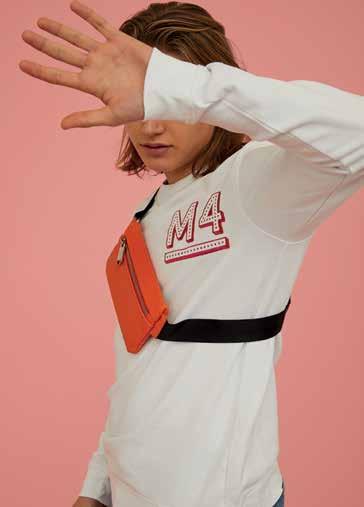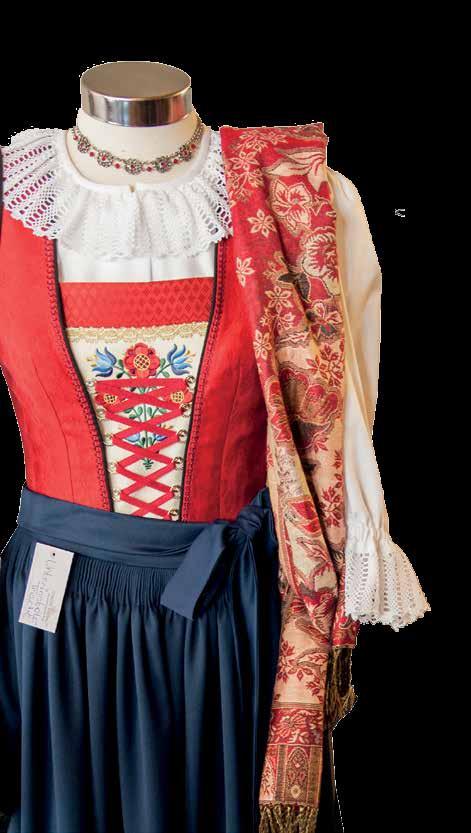
6 minute read
Einfach fesch
In der Ferienregion Hohe Salve tragen Frauen die Unterinntaler Tracht an Feiertagen und zu besonderen Anlässen. Für die Trachtenschneiderin Helene Mayr aus Kirchbichl gibt die Tradition den Rahmen für das Dirndl vor, in welchem auch viel Platz für die persönlichen Vorlieben der Trägerin bleibt.
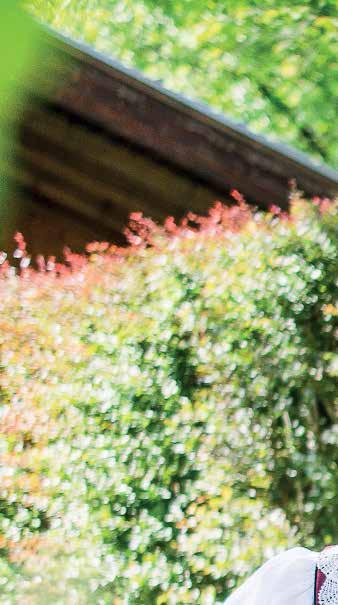
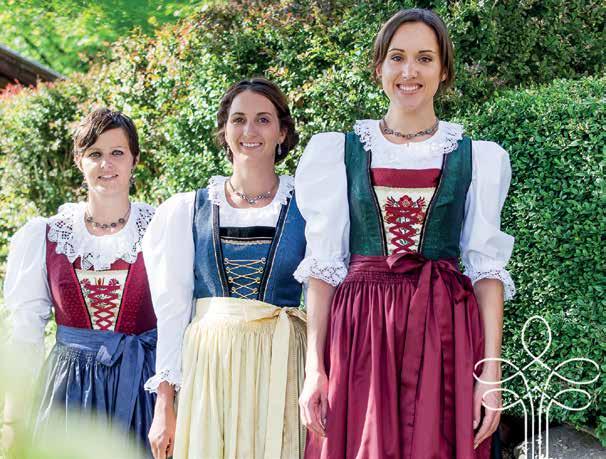
„
Einfach fesch!“ – treffender lässt sich Tracht wohl nicht beschreiben. Laut
Duden steht das typisch österreichische „fesch“ für angesagt, ansprechend, hübsch, modisch, reizend, chic, smart, sportlich, flott, trendig, hip, … – ja auch so lässt sich Tracht beschreiben, vor allem die Unterinntaler Tracht. Sie ist im
Unterinntal bis Schwaz und im Brixental bis Hopfgarten beheimatet – die Ferienregion Hohe Salve ist sozusagen das Kerngebiet.
Unterinntaler Tracht
Allerdings gibt es nicht DIE Unterinntaler Tracht, stellt Helene Mayr, Trachtenschneiderin aus Kirchbichl, fest: „Das Oberteil der Unterinntaler Tracht wird zum Beispiel mit rotem, grünem oder blauem Mieder aus Woll- oder Seidenbrokat getragen. Es kann aber auch ein einfärbiger, bestickter Seiden- oder Wollstoff verwendet werden. Die Schürze wird passend zum
Mieder abgestimmt.“ Die Trachtenschneidermeisterin sorgt mit ihrem Fachwissen und ihrem kreativen Umgang mit Nadel und Zwirn dafür, dass die Trachten bei Musikkapellen, Schützen, Trachtenvereinen usw. immer perfekt sitzen. „Ich bin überzeugt, dass eine stilecht gehaltene Tracht ohne starke Modeeinflüsse jede Zeit überleben kann“, so Helene, die seit über 30 Jahren in der Trachtenbranche tätig ist.
Tracht passt immer – zu jeder Gelegenheit. Sie ist multifunktional und lässt sich durch Variieren von Schürze, Tücher, Bluse oder Schmuck dem jeweiligen Anlass anpassen. Tracht kommt von „Tragen“ und hat sich in jedem Tal eigenständig entwickelt. Die verwendeten Materialien sagen einiges über die Geschichte, die Wirtschaft und die Kultur der jeweiligen Region aus. „Aber die Tracht verändert sich auch. Durch ständige Weiterentwicklung der Farben, Musterungen und Stoffqualitäten hat sich die traditionelle Schneiderkunst mit der heutigen vereint“, so die Schneidermeisterin. Dass Tracht auch bei der Jugend gefragt ist, hängt für Helene Mayr nicht nur mit der Rückbesinnung auf die Natur und das Ursprüngliche zusammen. „Eine Tracht unterstreicht die Persönlichkeit der Trägerin und kann deshalb von jeder Frau getragen werden. Durch das Mieder hat man automatisch eine aufrechte Haltung, das sieht gut aus und gibt Selbstvertrauen. Und mit der passenden Tracht zieht man alle Blicke auf sich“, weiß die leidenschaftliche Trachtenträgerin. Wohl mit ein Grund, dass die Tracht in den letzten Jahren einen regelrechten Boom erlebt. Das Dirndl ist auch das einzige Kleidungsstück, das ein Leben lang mitwächst. Es wird aus hochwertigen und durchaus teuren Stoffen gefertigt. Fachmännisch geändert, sitzt es immer wieder perfekt. ■

Ein zentrales Motiv der Unterinntaler Tracht ist der Lebensbaum. Dieses Glückssymbol ziehrt den Rücken des Dirndls. Das Blüten- bzw. Baummotiv auf dem Brustlatz symbolisiert die Sippe. The tree of life is a central motif of the traditional Lower Inn costume. The symbol of luck is stitched on the back of the dirndl, while the flower or tree motif on the bib symbolises the clan from which its wearer originates.

„
DIE TRACHT IST MULTIFUNKTIONAL
Helene Mayr

Move & Relax
UM IN BALANCE ZU SEIN, MUSST DU IN BEWEGUNG BLEIBEN
Das Hohe Salve Sportresort stellt Ihnen ein ganzes Team aus Fitnesstrainern, Sportwissenschaftlern, Coaches und vielen weiteren Experten zur Seite. Von diesem Team erwarten Sie ein maßgeschneidertes Trainingskonzept und eine persönliche Betreuung. Unsere Relax-Angebote helfen, sich richtig zu entspannen und neue Energie für den Alltag zu sammeln.
400 m2 Fitnessbereich mit funktionellsten Trainingsgeräten 25 m Sportbecken 630 m2 Poolbereich 380 m2 Regenerationsbereich mit Sauna, Infrarotkabinen, Dampfbad, Ruheräumen
UNSER TIPP: MOVE & RELAX DAY € 68,-
inkl. Energy-Frühstück & Teilkörpermassage
TERMINVEREINBARUNG
Das Hohe Salve Sportresort T +43 5335 2420 610 E moveandrelax@hohesalve.at


„
SCARVES, BLOUSES OR JEWELLERY.“
Helene Mayr

SIMPLY SNAZZY
In the Holiday Region Hohe Salve the “Unterinntaler - Lower Inn Valley” traditional costume is worn on religious holidays and significant festivals. For costume seamstress Helene Mayr from Kirchbichl, the “dirndl” dress design is based on traditional lines, although there is still plenty of room to incorporate the wearer‘s personal preferenes.
„
Simply snazzy” - is the perfect way to describe the traditional garb. According to Duden dictionary, the Austrian word „fesch“ stands for hip, appealing, pretty, fashionable, charming, chic, smart, sporty, jaunty, great, trendy, hip, ... - yes, you can also describe traditional costume in this way, especially the “Unterinntaler” traditional costume. It is worn in the Lower Inn Valley, from Schwaz to the Brixen Valley and as far as Hopfgarten - the Holiday Region Hohe Salve being its centre ground, so to speak.
Lower Inn Valley traditional costume
However, there is no such thing as „the one and only“ Lower Inn Valley traditional costume, as Helene Mayr, a costume tailor from Kirchbichl notes: „The upper part of the Lower Inn Valley traditional costume is worn with red, green or blue bodices made of wool or silk brocade, for example. However, a single-coloured, embroidered silk or wool fabric can also be used. The apron is matched to the bodice.“ With her expert knowledge and creative handling of needle and thread, the master seamstress for national costume ensures the traditional outfits worn by music bands, marksmen, traditional associations etc. always fit perfectly. „I am absolutely certain that a costume made in traditional style will never grow old“, says Helene, who has been working in this time-honoured profession for over 30 years. Traditional costume has always been worn on festive days in Tyrol. Whereby the following also applies: traditional costume can be worn for every occasion. It is multifunctional and can be adapted to suit any event by varying aprons, scarves, blouses or jewellery. The word “Tracht - traditional costume” is derived from the German word of “Tragen - to wear“ and has evolved differently in every valley. The materials used say a lot about the history, economy and culture of the respective region. “The costume has also undergone change over time. Thanks to the constant development of colours, patterns and fabric qualities, we use a combination of traditional and contemporary tailoring“, says the master seamstress. As far as Helene Mayr is concerned, the fact that traditional costume is also in high demand amongst young people is not only due to a growing need to return to nature and original values. „A costume emphasises the personality of the wearer and can therefore be worn by every woman. The bodice automatically improves posture, which looks good and lends self-confidence. And, with the right costume, you will draw everyone’s attention“, knows the passionate wearer of traditional dress. This is probably one of the reasons why traditional costumes have been experiencing a renaissance in recent years. A dirndl is also the only piece of clothing that grows with you throughout your life. It is made from high-quality and expensive fabrics that look like new - even after decades. Expertly altered, it is always a perfect fit. ■
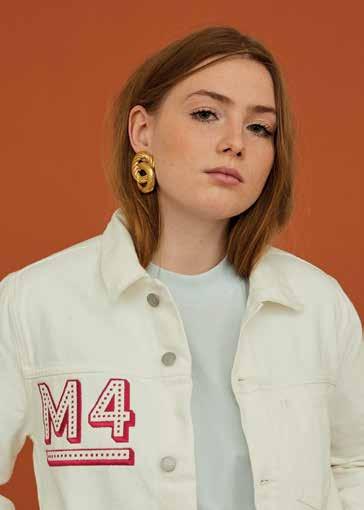
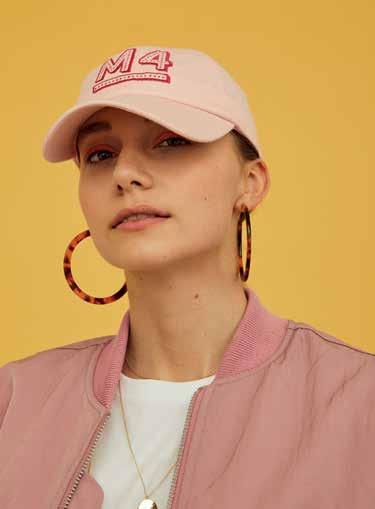

40 SHOPS · XL FITNESS 8 CAFÉS / RESTAURANTS CINEPLEXX-KINO
